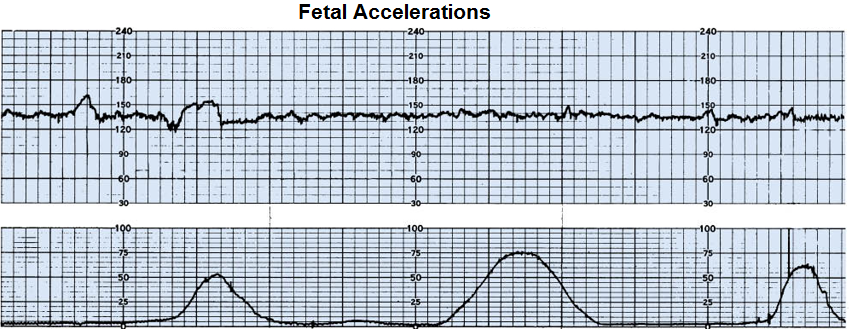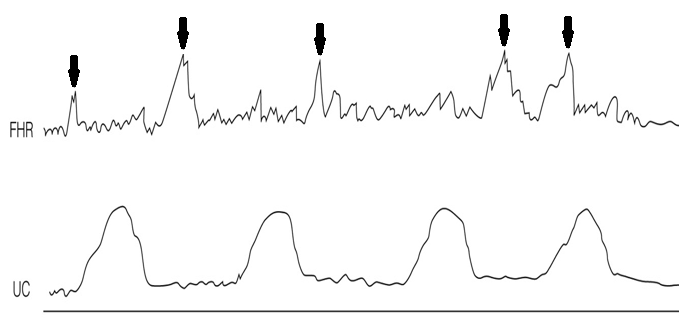Fetal Accelerations- Explained

Fetal accelerations are a temporary increase in the heart rate of a fetus in which there is a increase of 15 beats per minute (bpm) above the baseline for 15 seconds.
Fetal accelerations are associated with fetal movement and are a reassuring sign because it shows that the infant is well and moving.
If accelerations were never present in late stages of pregnancy especially, this could be an alarming sign that the fetus may not be moving much and may not be well.
So with fetal accelerations on a graph, you will see sharp increases in fetal heart rate at irregular intervals during a time period. It's associated with whenever the fetus is moving.
Fetal accelerations are part of reassuring fetal heart rate (FHR) patterns. Reassuring FHR patterns are things that reassure us that all is normal and well with the fetus. The reassuring FHR patterns include a baseline fetal heart rate in the normal range of 110-160 bpm, absence of nonreassuring decelerations, moderate variability, and accelerations with fetal movement.
The normal baseline for a fetus is 110-160 bpm. We want to see the fetus at a heart rate in this level when assessing the heart rate. We do not want to see the infant tachycardic (above 160 bpm) or bradycardic (less than 110 bpm). So this baseline is one reassuring FHR pattern.
We also want to see the absence of nonreassuring decelerations. These would include late and variable decelerations. Early decelerations are okay.
By variability, we are talking about fluctuations in the heart rate by a certain amount over a period of time. We do not want to see the fetus just stay at one heart rate because things such as moving should increase it. So we want to see moderate level of variability in the heart rate.
The last, which is the subject of this article, is accelerations with fetal movement. This is assuring because if the fetus is moving around, the fetus is alive and has the strength of mobility. The fetus should move around. Moving around is a sign of well-being, as opposed to the absence of movement.
So now that we know that accelerations are a good and part of a reassuring fetal heart rate pattern, let's see how they look on graphs, so that you will be able to recognize and interpret them.
Below is a graph showing FHR accelerations.

So here we have 2 graphs. The bottom graph represents and is measuring the mother's uterine contractions, which are contractions of the uterus. Remember the contractions are measured while a woman is in labor. These graphs are taken while a a woman is in labor. So she is having contractions at these times. The top graph represents the heart rate of the fetus. Therefore, we are able to monitor the fetal heart heart with the contractions, to see whether there is a correlation or not.
The contractions are measured in mmHG, which you see at the bottom of the horizontal axis of the bottom graph. The heart rate, the top graph, is measured as the numerical beats per minute.
In this graph, the contractions do not correlate with the accelerations. The accelerations are independent of the contractions and more than likely correlate with fetus movement.
Though there are spikes in heart rate at several points in the graph, the first 2 are the most prominent accelerations. Based on the graph, the baseline fetal heart rate is about 135bpm. In the first spike, the heart rate increases to about 160 bpm before going back to baseline. Since each box is worth 10 seconds of time, you can see that it takes about 10 seconds (1 box) for the heart rate to go from baseline to 160 bpm, and it takes another 10 seconds (1 box) for the heart rate to go back down to baseline. So the whole increase from baseline to peak and drop back down to baseline takes about 20 seconds.
In the next accleration, the heart rate rises to about 155 bpm, not as high of a peak as the last spike; however, unlike the last one, the elevated heart rate is lasts a longer period of time. The heart rates stays elevated at this peak for about 30 seconds (3 boxes) before going back to baseline. So the whole process of elevating from the baseline and going back down to baseline takes 50 seconds (5 boxes).
There are a few more accelerations in this graph. However, they are not nearly as steep as the first 2 accelerations discussed above. Some just meet the 15 bpm increase in order to be considered an acceleration.
Again, accelerations are a reassuring sign and are associated with fetal movement.
Another graph showing fetal accelerations is shown below.

So, just like first graph, this graph shows uterine contractions (UC) at the bottom and fetal heart rate (FHR) at the top.
Here, you can see several spikes upward, which represent accelerations.
Again, these accelerations are independent of uterine contractions and signify fetal movement.
So this is fetal accelerations in a nutshell.